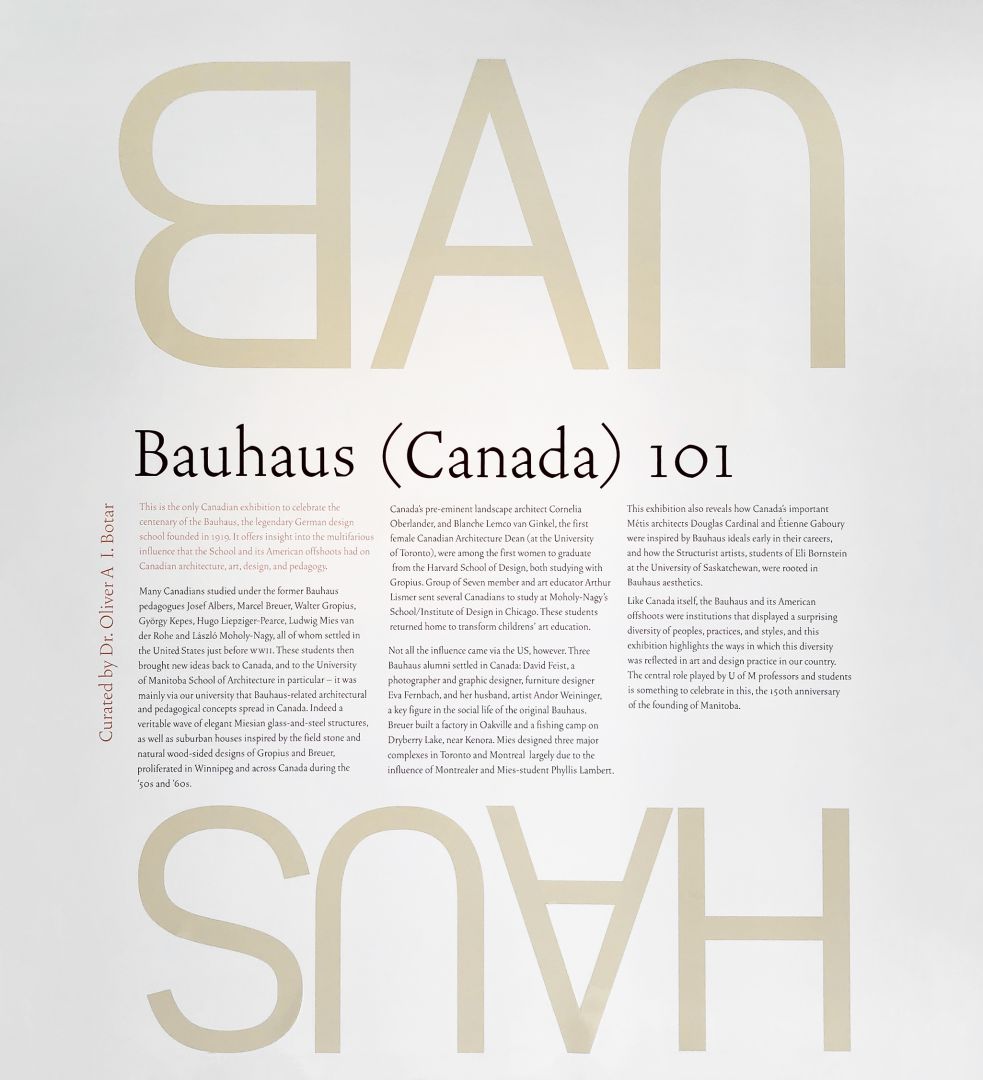Entrance
Bauhaus (Canada) 101
This is the only Canadian exhibition to celebrate the centenary of the Bauhaus, the legendary German design school founded in 1919. It offers insight into the multifarious influence that the School and its American offshoots had on Canadian architecture, art, design, and pedagogy.
Many Canadians studied under the former Bauhaus pedagogues Josef Albers, Marcel Breuer, Walter Gropius, György Kepes, Hugo Liepziger-Pearce, Ludwig Mies van der Rohe and László Moholy-Nagy, all of whom settled in the Unites States just before WWII. These students then brought new ideas back to Canada, and to the University of Manitoba School of Architecture in particular – it was mainly via our university that Bauhaus-related architectural and pedagogical concepts spread in Canada. Indeed a veritable wave of elegant Miesian glass-and-steel structures, as well as suburban houses inspired by the field stone and natural wood-sided designs of Gropius and Breuer, proliferated in Winnipeg and across Canada during the ‘50s and ‘60s.
Canada’s pre-eminent landscape architect Cornelia Oberlander, and Blanche Lemco van Ginkel, the first female Canadian Architecture Dean (at the University of Toronto), were among the first women to graduate from the Harvard School of Design, both studying with Gropius. Group of Seven member and art educator Arthur Lismer sent several Canadians to study at Moholy-Nagy’s School/Institute of Design in Chicago. These students returned home to transform childrens’ art education.
Not all the influence came via the US, however. Three Bauhaus alumni settled in Canada: David Feist, a photographer and graphic designer, furniture designer Eva Fernbach, and her husband, artist Andor Weininger, a key figure in the social life of the original Bauhaus. Breuer built a factory in Oakville and a fishing camp on Dryberry Lake, near Kenora. Mies designed three major complexes in Toronto and Montreal, largely due to the influence of Montrealer and Mies-student Phyllis Lambert.
This exhibition also reveals how Canada’s important Métis architects Douglas Cardinal and Étienne Gaboury were inspired by Bauhaus ideals early in their careers, and how the Structurist artists, students of Eli Bornstein at the University of Saskatchewan, were rooted in Bauhaus aesthetics.
Like Canada itself, the Bauhaus and its American offshoots were institutions that displayed a surprising diversity of peoples, practices, and styles, and this exhibition highlights the ways in which this diversity was reflected in art and design practice in our country. The central role played by U of M professors and students is something to celebrate in this, the 150th anniversary of the founding of Manitoba.
Many thanks to our generous lenders: Canada Modern, the Centre du Patrimonie de la Société historique de St. Boniface, Prof. Herbert Enns and Maem Slater-Enns, Alison Gillmor, Antoine Holtmaat, Dr. Serena Keshavjee, Prof. Neil Minuk, Dr. Michael Nesbitt, Michael Szarvasy, The Salgo Trust for Education, Jeffrey Thorsteinson and Brennan Smith, the University of Manitoba Faculty of Architecture, the University of Manitoba Libraries, the University of Manitoba Archives and Special Collections and The Winnipeg Architecture Foundation, as well as to others who have helped: Susan Algie, Nadir Botar, Thomas Derda, Prof. Terri Fuglem, Marieke Gruwel, Sabine Hartmann, Brian Hubner, Phyllis Lambert, Chloe Loris, Hattula Moholy-Nagy, Rachelle Ross, Sara Sutcliffe, Dr. Shelley Sweeney, Blair Thomson, the Canadian Architectural Archives at the University of Calgary, and the Canadian Centre for Architecture in Montreal. Finally, heartfelt thanks are due to colleagues at the School of Art who helped make this show happen: Trevor Baziuk, Genevieve Farrell, Blair Fornwald, Donna Jones, Shelley McCafferty, Prof. Daniel McCafferty, Kanchana Sankaranarayanan, Dr. Jeff Taylor and Jamie Wright.
This exhibition was designed to support coursework at the University of Manitoba, and I would like to dedicate it to all my students, past and present, who have contributed to it through their research and discussions.
Financial support has been received from Arthur and Judy Drache (Ottawa) and The Salgo Trust for Education (New York). Thanks to the Social Sciences and Humanities Research Council of Canada for research support related to this project over two decades.
Dr. Oliver A. I. Botar, Curator
